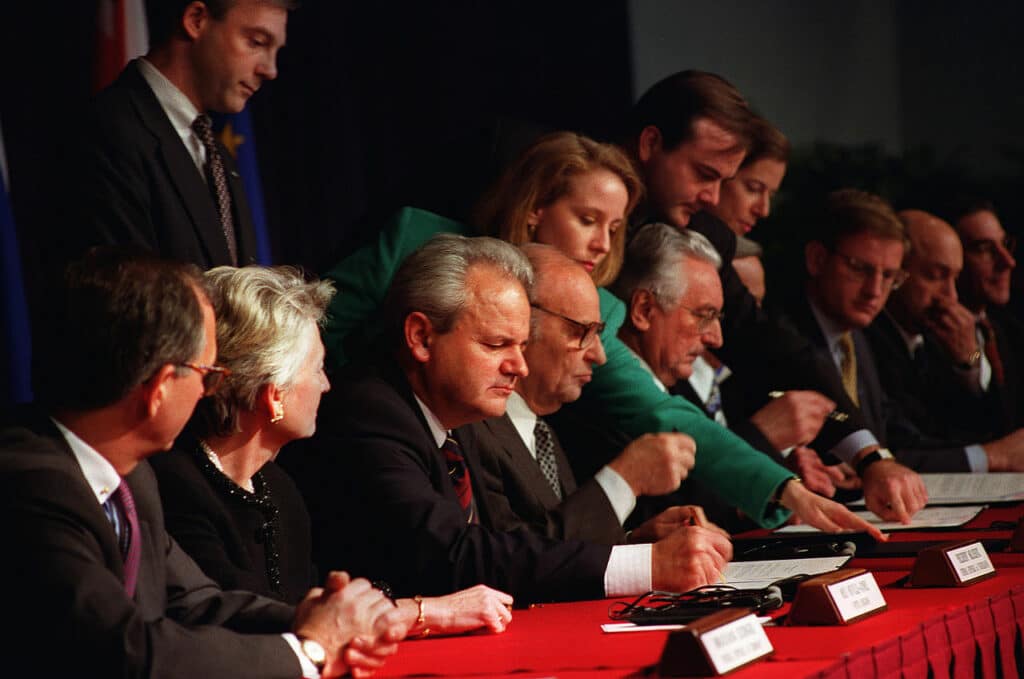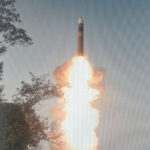The United States has supported successful mediation in 11 vicious conflicts since 1990: Could Ukraine make it an even dozen?
By Stephen R. Weissman | April 27, 2022

Up to now, the United States, along with its Western partners, has been rightly preoccupied with furnishing Ukraine the weapons needed to defend itself against massive Russian aggression, ramping up crushing economic sanctions against Russia, and decrying the latter’s war crimes. However, they also need to use their considerable leverage with both sides to promote neutral third-party mediation to deescalate this particularly dangerous war. US and Western policy makers should remember that their predecessors’ support for such mediations has helped settle 11 vicious civil wars and interstate conflicts since 1990.
The very existence of so many cases suggests that Ukraine and Russia are unlikely to reach an enduring peace agreement by themselves, at least in the foreseeable future. After mediating the genocidal conflict in Burundi for two years, former Tanzanian President Julius Nyerere told me, “One thing I know. They can’t do it on their own.” Irregular phone calls and meetings with the Ukraine combatants by a changing cast of concerned world leaders testify to their belief that third party intervention is necessary to stem the crisis. But they are no substitute for a well-structured peace process, one led by a prime mediator like the United Nations or a small group of countries acceptable to Russia and Ukraine and bolstered by other relevant nations.
No doubt the 11 conflicts, from Bosnia to Sudan, would have eventually ended on their own, or at least been interrupted for a time. But the costs of delayed, do-it-yourself peacemaking can be extremely high, as we have seen recently in Afghanistan and the Iran-Iraq War.
Mediation becomes opportune when it appears that neither party is likely to achieve a military victory within a short-to-medium time frame. While no one knows what the exact military balance in Ukraine will look like in the next few months or possibly years, it is most unlikely that the larger and more powerful combatant, Russia, will be totally defeated—no matter how many Western arms flow to a much smaller Ukraine. Even if some of Russia’s recent advances in the South and East are reversed, President Vladimir Putin can be expected to fight on for a considerable time, given his deeply felt security concerns and personal political interest in some sort of “victory.”
If neither side can fully impose its will, they and the world could be looking at a brutal conflict that kills up to hundreds of thousands of people. By some estimates, tens of thousands, military and civilian, have already died. And the longer the Ukraine war continues, the greater the damage the international community will suffer due to disruption of the global economy that affects food security in many countries and to diversion of attention from urgent issues like climate change and nuclear nonproliferation. This is not to mention the potential for military, even nuclear, confrontation between Russia and NATO. So, the consequences of continued war in Ukraine could exceed those incurred in any conflict since Vietnam.
There is a plausible alternative to this bleak scenario. It is third-party mediation rooted in recognition of on-the-ground power relations, leavened by as much justice as a neutral intermediary can elicit. From 1990-2005 the United States supported mediations that produced agreements ending 11 conflicts that had killed anywhere from tens of thousands to nearly 4 million people in Bosnia, Burundi, Cambodia, Democratic Republic of the Congo, El Salvador, Guatemala, Mozambique, Namibia, Nicaragua, Northern Ireland and Sudan. Although all but one of these settlements concerned civil wars, half also involved interstate conflicts and relations—including some with great powers. For example, the principal signatories of the Dayton Peace Agreement on Bosnia were the states of Serbia, Croatia and Bosnia, and NATO was strongly involved in the conflict. The Cambodia accord became possible when China and Vietnam made a secret deal. And the US Congress’s withholding of military aid to the Government of El Salvador was instrumental in its UN-mediated peace settlement. In five of the 11 conflicts, war crimes trials were held, but only after the peace accords were well-established.
While many of these peace agreements were flawed, fell under significant strain, and were later revised, not one has dissolved into renewed war.
A rich literature, including many first-person accounts, describes how the mediators nurtured agreements in conflicts that were either “ripe” for resolution (i.e. where the parties appeared to perceive they could not win and the costs of continuing were higher than the costs or prospects of a settlement) or needed further “ripening.”
They listened carefully to the parties’ concerns, neutrally explained them to the participants, and employed their reputation for even-handedness to find a middle ground. They arranged technical assistance to resolve delicate military and political issues. They built an architecture for achieving consensus: ordering agendas, setting target dates for decisions, determining how to incorporate combatants’ external sponsors into the discussions, calculating when to utilize indirect “proximity talks” or face-to-face meetings and deciding when to insist that the parties accept their recommended compromise or precipitate the collapse of the entire effort.
These negotiations contained an important social-psychological component. By developing a degree of political and personal trust among the participants, they reduced their fears and gave them a sense of joint ownership of a political dialogue.
The peacemakers also wielded various forms of leverage. The prime mediators and/or their key auxiliaries were politically important to the warring parties. They were able to offer “carrots” for cooperation such as economic assistance, political financing, lifting international economic sanctions, dispatching international forces to provide security during a foreign withdrawal or political transition, and procuring the blessings of the combatants’ external supporters. And they could wield “sticks” to discourage resistance, including threats to increase or reduce military assistance to one side or other. Such threats played a major role in the achievement of the historic Dayton peace agreement on Bosnia as well as the accords on Sudan and El Salvador.
Richard Holbrooke, the US official who served as mediator in the months leading to the Dayton agreement conveyed something of the flavor of that role in a note to Secretary of State Warren Christopher, who was preparing to visit the Dayton conference:
You can jump start this conference by a combination of pressure, rhetoric and direct involvement on some issues where you can break a logjam… All the parties want peace, but they still don’t know how to get it. They look forward to our helping them stop killing each other—and so do we.
There are some signs that a political settlement could be feasible in Ukraine. In the first place, representatives of both sides have been holding discussions since the beginning of the war. This kind of direct communication rarely occurred in the 11 earlier cases, even during mediations.
Second, both sides appear to have scaled down their initial demands more quickly than has occurred elsewhere. Ukraine began with an insistence on Russian withdrawal. Russia proclaimed its goal of “denazification” and “demilitarization” of Ukraine, including no membership in NATO. Within weeks, both parties’ positions have narrowed. Ukraine said it would stop pursuing NATO membership if its security could be otherwise guaranteed by a group of countries. Russia switched its major focus from implied regime change to recognition of the independence of two Eastern Ukraine regions where Russian-backed separatists have fought since 2014 and official recognition of the Russian language. Territorial excision is unacceptable to Ukraine, but it has indicated its willingness to negotiate on the internal status of portions of the Donbas region, as well as language issues. Actually, both parties had seemingly settled the Donbas issue through autonomy arrangements for separatist controlled areas in the French-German mediated Minsk Agreement of 2015. But these were never implemented because of disagreements over the sequencing of its provisions and the lethargy of the mediators.
If a negotiated solution in Ukraine is sought, it will be important to establish the mediation early, even as fighting rages. Generally, it has taken around two years to complete a peace agreement, though the issues in dispute elsewhere have usually been more complex than those in Ukraine.
It is unclear whether the Biden administration and its partners have the vision to use their accumulated military and economic leverage to push for a mediated political solution. Interestingly, then-Senator Joe Biden was a leading figure in congressional debate on the Bosnian war and political settlement during the early 1990s. He initially favored lifting a UN arms embargo and conducting air strikes to “let the Bosnian government establish itself,” thereby creating a balance of power with the Bosnian Serbs “essential for maintaining a lasting peace.” Although his advice was not taken, he endorsed the compromise Dayton Agreement and subsequently suggested it as a model for a political solution for Iraq’s sectarian conflicts.
On the other hand, some of Biden’s top foreign policy advisers are Obama administration veterans who failed to grasp potential opportunities to support mediated political solutions in Libya, Yemen and Syria. For example, both the United States and Russia were militarily involved in the battle over regime change in Syria but agreed to sponsor UN mediation. Yet that effort has dissipated, partly because of inconsistent support from the American side. Sadly, the United States continues to confront the tragic legacies of these past policies. The same need not be true for Ukraine.
Together, we make the world safer.
The Bulletin elevates expert voices above the noise. But as an independent nonprofit organization, our operations depend on the support of readers like you. Help us continue to deliver quality journalism that holds leaders accountable. Your support of our work at any level is important. In return, we promise our coverage will be understandable, influential, vigilant, solution-oriented, and fair-minded. Together we can make a difference.
Keywords: Bosnia, Burundi, Cambodia, Democratic Republic of the Congo, El Salvador, Guatemala, Mozambique, Namibia, Nicaragua, Northern Ireland, Richard Holbrooke, Russia, Sudan, Ukraine, negotiations, third-party mediation
Topics: Nuclear Risk
















I see Dr. Weissman is a geographic expert in many regions, but not the Balkans or the former Soviet Union. The Dayton Accords, originally called a “ceasefire” has given the Russian-backed Serbian aggressors decades long control over their victims and kept the region permanently perched on the brink of more violence and away from European integration. Bosnians were on their way to defeating Serbia…and preventing the Kosovo conflict… until Holbrooke forced them to accept the humiliating Dayton agreement. No, a negotiated settlement did not provide a better outcome than letting the Bosnians finish the war. Likewise, negotiations to settle Transnistria,… Read more »